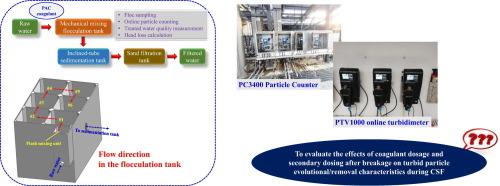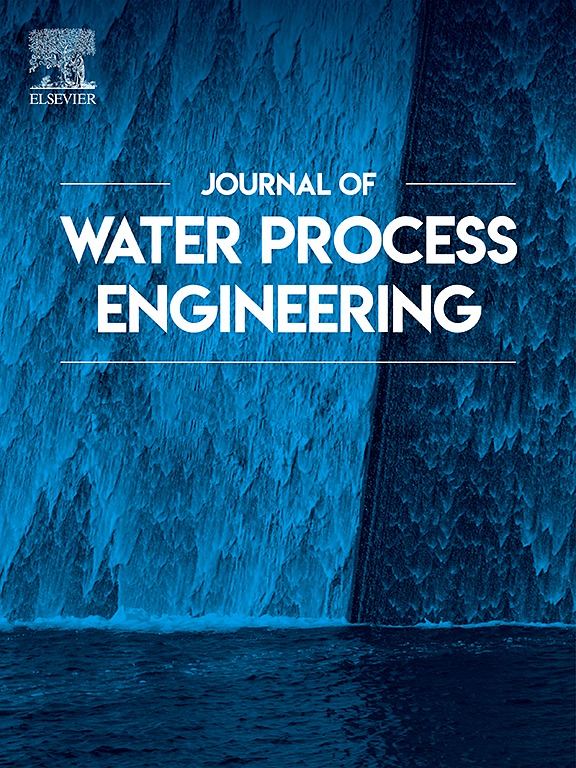Pilot-scale study of turbid particle evolutional/removal characteristics during coagulation-sedimentation-filtration (CSF): Effects of coagulant dosage and secondary dosing after breakage
IF 6.3
2区 工程技术
Q1 ENGINEERING, CHEMICAL
引用次数: 0
Abstract
Considering the limitations of treated water turbidity, a thorough understanding of the changes in turbid particle size distribution during coagulation-sedimentation-filtration (CSF) is crucial for enhancing the removal efficiency of particulate and dissolved contaminants from raw water. In this study, a pilot-scale experimental system was utilized to track the evolution of turbid particles and assess how the characteristics of these turbid particles affected the quality of treated water in the CSF processes under varying cases of polyaluminum chloride (PAC) coagulant dosage and secondary coagulant dosage after breakage. It was found that differently from the role of PAC coagulant dosage (without high-shear breakage), different levels of secondary coagulant dosing after breakage had minimal influence on the aggregate structure produced by mechanical stirring flocculation. During the overall CSF processes, the changing trend in the total particle number for the filtered water appeared to be more consistent with the corresponding changing trend for the settled water, as the PAC coagulant dosage increased. In addition, the combined effects of shear-induced breakage and secondary dosing could not only improve the removal efficiency of organic matter after inclined-tube sedimentation following mechanical stirring flocculation, but also enhance the removal efficiencies of water turbidity and particulate matter through sand filtration. In order to reduce the frequency of backwashing and extend the service life of the filter media, greater emphasis should be placed on detecting and removing the number of smaller-sized particles existing in the sixth unit of the flocculation tank together with the effluent of the sedimentation tank.

混凝沉淀过滤(CSF)过程中浑浊颗粒演变/去除特性的试验性研究:混凝剂用量和破碎后二次加药的影响
考虑到处理水浊度的局限性,深入了解混凝沉淀过滤(CSF)过程中浑浊颗粒粒度分布的变化对于提高原水中颗粒和溶解污染物的去除效率至关重要。本研究利用一个中试规模的实验系统来跟踪浑浊颗粒的演变过程,并评估在不同的聚合氯化铝(PAC)混凝剂投加量和破碎后二次混凝剂投加量情况下,这些浑浊颗粒的特性如何影响 CSF 过程中的处理水水质。研究发现,与聚合氯化铝(PAC)混凝剂投加量(无高剪切破碎)的作用不同,破碎后二次混凝剂的不同投加量对机械搅拌絮凝产生的聚合体结构影响极小。在整个 CSF 过程中,随着 PAC 混凝剂投加量的增加,过滤水的总颗粒数变化趋势似乎与沉淀水的相应变化趋势更加一致。此外,剪切力诱导破碎和二次加药的共同作用不仅能提高机械搅拌絮凝后斜管沉淀对有机物的去除效率,还能提高砂滤对水体浊度和颗粒物的去除效率。为了减少反冲洗次数和延长滤料的使用寿命,应更加重视检测和清除絮凝池第六单元中与沉淀池出水一起存在的较小尺寸颗粒的数量。
本文章由计算机程序翻译,如有差异,请以英文原文为准。
求助全文
约1分钟内获得全文
求助全文
来源期刊

Journal of water process engineering
Biochemistry, Genetics and Molecular Biology-Biotechnology
CiteScore
10.70
自引率
8.60%
发文量
846
审稿时长
24 days
期刊介绍:
The Journal of Water Process Engineering aims to publish refereed, high-quality research papers with significant novelty and impact in all areas of the engineering of water and wastewater processing . Papers on advanced and novel treatment processes and technologies are particularly welcome. The Journal considers papers in areas such as nanotechnology and biotechnology applications in water, novel oxidation and separation processes, membrane processes (except those for desalination) , catalytic processes for the removal of water contaminants, sustainable processes, water reuse and recycling, water use and wastewater minimization, integrated/hybrid technology, process modeling of water treatment and novel treatment processes. Submissions on the subject of adsorbents, including standard measurements of adsorption kinetics and equilibrium will only be considered if there is a genuine case for novelty and contribution, for example highly novel, sustainable adsorbents and their use: papers on activated carbon-type materials derived from natural matter, or surfactant-modified clays and related minerals, would not fulfil this criterion. The Journal particularly welcomes contributions involving environmentally, economically and socially sustainable technology for water treatment, including those which are energy-efficient, with minimal or no chemical consumption, and capable of water recycling and reuse that minimizes the direct disposal of wastewater to the aquatic environment. Papers that describe novel ideas for solving issues related to water quality and availability are also welcome, as are those that show the transfer of techniques from other disciplines. The Journal will consider papers dealing with processes for various water matrices including drinking water (except desalination), domestic, urban and industrial wastewaters, in addition to their residues. It is expected that the journal will be of particular relevance to chemical and process engineers working in the field. The Journal welcomes Full Text papers, Short Communications, State-of-the-Art Reviews and Letters to Editors and Case Studies
 求助内容:
求助内容: 应助结果提醒方式:
应助结果提醒方式:


